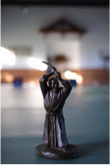 Everyone was busy preparing the dojo. Sweeping the floor. Cleaning the mats. Setting up the benches for the morning prayer and meditation. Saito Sensei arrives at the dojo bringing along what he had shopped at the market for our meals for days to come. After some greetings and a quick change, so began the 3rd Philippine Gasshuku.
Everyone was busy preparing the dojo. Sweeping the floor. Cleaning the mats. Setting up the benches for the morning prayer and meditation. Saito Sensei arrives at the dojo bringing along what he had shopped at the market for our meals for days to come. After some greetings and a quick change, so began the 3rd Philippine Gasshuku.
Even though there were only a few participants this year, we were fortunate to have enjoyed the presence of Simon Harris and Daniel Brasse in addition to the other local students. As expected, Saito Sensei had us mostly do kihon practice and some ki no nagare somewhere in between. I shall not bore you with a list of the techniques that we did over the week but we were able to do some interesting stuff! The advantage of having a few students practicing on the mats is that Saito Sensei’s attention is divided less so corrections were made and pointed out every so often. It also keeps everyone on his or her toes! Although, I personally think that he can see everything even when he is not looking!
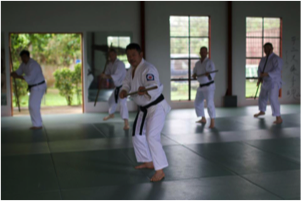 Training was hard and fun! By the end of the week, practically everyone was hurting somewhere! Muscles were sore and aching everywhere! Yet, everyone was still smiling and enjoying the experience!
Training was hard and fun! By the end of the week, practically everyone was hurting somewhere! Muscles were sore and aching everywhere! Yet, everyone was still smiling and enjoying the experience!
Mealtime was something to look forward to as well. Saito Sensei and Ariel Supremo were the chefs for the week. 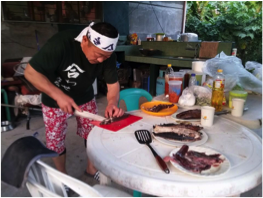 The rest of us helped with food preparations. Aside from being able to enjoy Sensei’s cooking, such as his sashimi, noodles and tongue numbing chili paste, Sensei told stories which everyone eagerly listened to. Thanks to the translation of Simon, we could all understand Sensei better. At times, Sensei would tell his stories with actions and facial expressions which made it more fun and easier to understand. The best part during these times was how at ease everyone is with one another. It was like we were all friends of equal stature gathered around having a meal together. In fact, this was one of the points that Saito Sensei kept on stressing.
The rest of us helped with food preparations. Aside from being able to enjoy Sensei’s cooking, such as his sashimi, noodles and tongue numbing chili paste, Sensei told stories which everyone eagerly listened to. Thanks to the translation of Simon, we could all understand Sensei better. At times, Sensei would tell his stories with actions and facial expressions which made it more fun and easier to understand. The best part during these times was how at ease everyone is with one another. It was like we were all friends of equal stature gathered around having a meal together. In fact, this was one of the points that Saito Sensei kept on stressing. 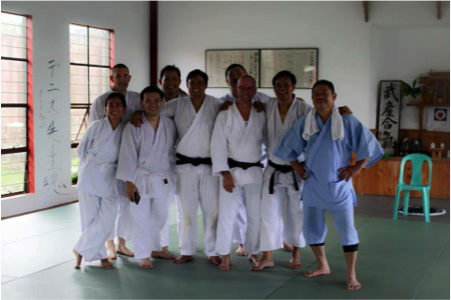 We, as members of the Iwama Shin Shin Aikishuren-kai, belong to a big family. We are not built like a corporation. After hard practice, he loves the personal time shared when preparing and cooking meals together. The Iwama family bond goes beyond keiko. As such, we have a direct lineage from O sensei to Morihiro Saito Sensei to Hitohira Saito Sensei. Then we as students have the responsibility to share and carry on the legacy of Iwama Ryu.
We, as members of the Iwama Shin Shin Aikishuren-kai, belong to a big family. We are not built like a corporation. After hard practice, he loves the personal time shared when preparing and cooking meals together. The Iwama family bond goes beyond keiko. As such, we have a direct lineage from O sensei to Morihiro Saito Sensei to Hitohira Saito Sensei. Then we as students have the responsibility to share and carry on the legacy of Iwama Ryu.
By the way, the chili paste that Saito Sensei made from fresh local chilis called sili labuyo was really a challenge to eat. Whenever sensei ate it, he’d exclaim that it was very dangerous! He would wince and his face would get all red! Funny thing is that he’d go for more helpings each time adding it to almost everything! I, myself, surrendered after one try. We dubbed it as “The Bomb”!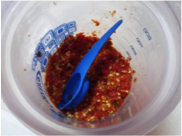
The gasshuku wasn’t all about serious practice day in and day out. As Saito Sensei would say, there must be a balance! Therefore, a karaoke night was planned. It was to be a night of simple fun with lots of memories to keep. About halfway through dinner, the singing began. Duets and solo performances filled the dojo. The best part was when everyone joined in the singing when a fun and familiar song was sung. Unfortunately, there weren’t any Japanese songs available but Saito Sensei wasn’t fazed. He serenaded us by a capella. He even sang “Hattori”, the uchideshi song. 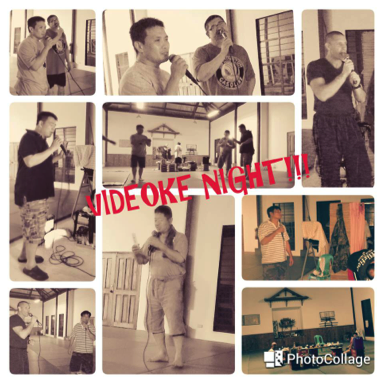
During karaoke night, Saito Sensei was in such a good mood that he suddenly told Gil San to put on his gi. Sensei took out his brush and ink then started to draw on his back. Now that surely is a most wonderful keepsake! He also wrote on the wall to commemorate Tatoian Sensei. How we all wished he were there to join us!
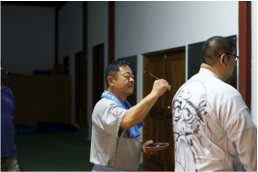
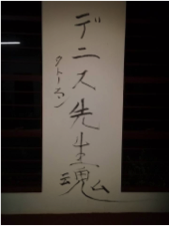
Amidst the numerous ideas and reminders that Saito Sensei tried to impart to us, I would like to share some of the insights that I was able to gather during the week:
• Do the basics! Kihon! Kihon! Kihon!
• Lower your hips to maintain and keep your balance!
• Never mind if your partner is bigger and stronger. Don’t worry about trying to throw your partner. Just mind your own balance and posture.
• Learn the physical limitations of your partner/opponent so that you can take their balance.
• Don’t ask too many questions! If you have queries then try to figure it out by watching carefully and training even more.
• The difference between a good and bad keiko doesn’t depend on what technique is being taught but it rather depends on your own attitude and heart. It depends on how you approach the training and how you practice. So practice earnestly!
• During practice, always give 100% so that your partner will reciprocate your energy!
• The best way to learn is to train with a beginner. Don’t look down upon them and try to pull them up to your level. Instead, you should go down to the level of the beginner then train together and grow together.

